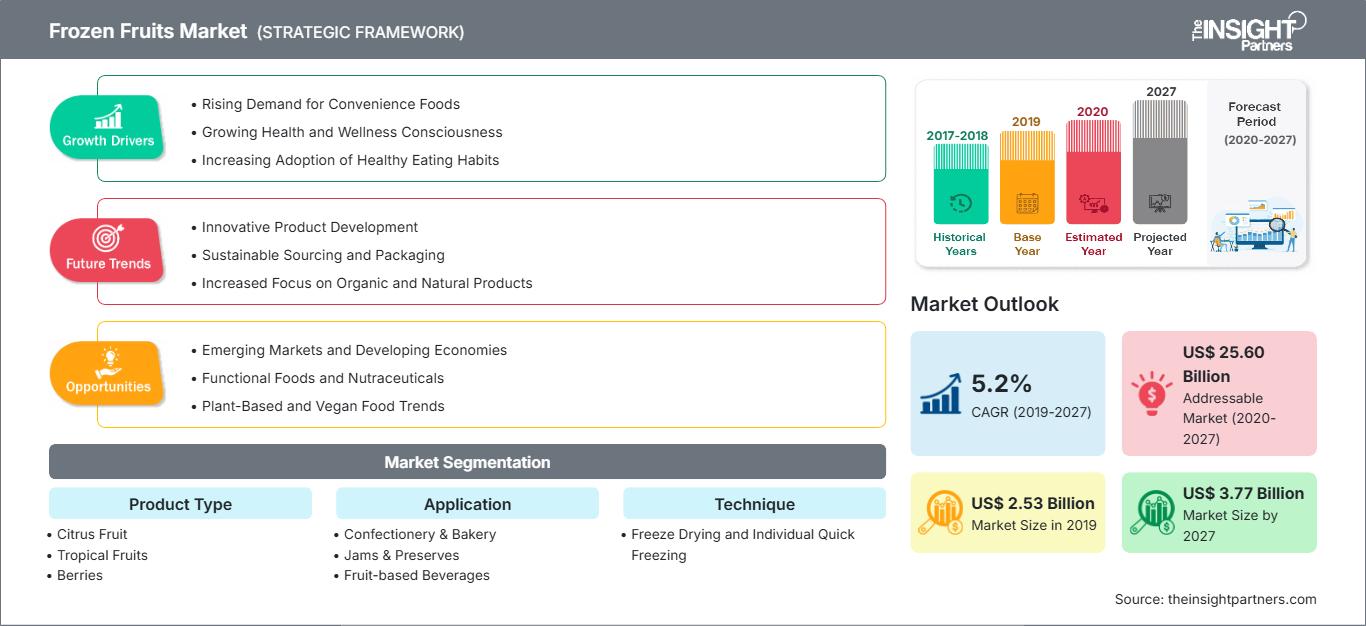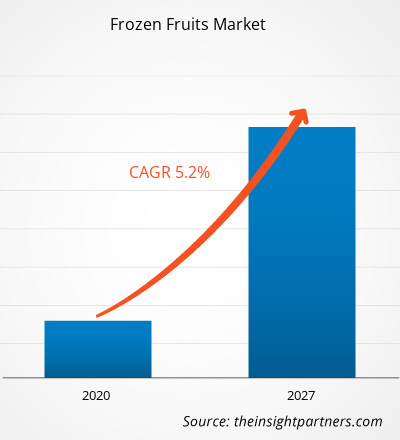The Frozen Fruits Market size is projected to reach US$ 47.74 billion by 2031 from US$ 35.15 billion in 2024. The market is expected to register a CAGR of 4.5% during 2025–2031.
Frozen Fruits Market Analysis
The market of frozen fruits is expanding due to the rise in demand for convenient, long-lasting, and healthy food products among consumers. With the increasing preference for ready-to-use ingredients due to busy lifestyles, frozen fruits provide year-round supplies without any loss in nutritional content. Increased health awareness has also led to an increase in the consumption of fruits, especially in smoothies, desserts, and breakfast foods. The development of new freezing technologies has enhanced the quality, texture, and taste of products, further boosting market growth. Additionally, the rise of e-commerce and retail distribution has increased access to frozen fruits for more consumers. The overall market demand is also supported by the use of frozen fruits as economical and consistent components in a range of food products, processed and packaged, by foodservice industries and their manufacturers.
Frozen Fruits Market Overview
Frozen fruits are fresh fruits that have been picked at the prime of their ripeness and frozen swiftly in order to maintain their nutritional worth, taste, and texture. Common examples include berries, mangoes, pineapples, peaches, and various fruit combinations. They are usually made without added sugars or preservatives and are therefore a natural and convenient choice for consumers. Frozen fruits are favored for several reasons. First, they provide a year-round supply, with or without seasonal harvests, which gives them consistent access to numerous types of fruits. Second, the rapid-freezing methodology preserves the nutrient value and important aspects of the food, so that it is as healthy, or sometimes even more so, than fresh fruits that are exposed to transport and storage and may have lost their quality. They also minimize food waste due to their long shelf life, allowing them to be stored, cut, and processed into smoothies, baked goods, and cooking ingredients.
Customize This Report To Suit Your Requirement
You will get customization on any report - free of charge - including parts of this report, or country-level analysis, Excel Data pack, as well as avail great offers and discounts for start-ups & universities
Frozen Fruits Market: Strategic Insights

-
Get Top Key Market Trends of this report.This FREE sample will include data analysis, ranging from market trends to estimates and forecasts.
Frozen Fruits Market Drivers and Opportunities
Market Drivers:
- Growing Health Awareness: Consumers prefer nutritious, preservative-free fruits for healthier diets and lifestyles.
- Rising Vegan/Vegetarian Trends: An increase in the popularity of plant-based diets boosts the demand for frozen fruit options.
- Year-Round Availability: Frozen products ensure access to seasonal fruits throughout the year.
- Technological Advancements: Improved freezing methods retain nutrition, texture, and flavor, attracting consumers.
- Rising Demand for Convenience: Frozen fruits offer quick, easy dessert prep with minimal effort.
Market Opportunities:
- Expanding Foodservice Partnerships: Collaborating with restaurants and cafeterias to increase frozen fruit usage
- Developing Specialty and Organic Lines: Offering organic, non-GMO, and specialty fruit options to capture niche markets
- Targeting Emerging Ethnic Cuisines: Introducing frozen fruits catering to diverse cultural food preferences
- Leveraging Functional Food Trends: Increasing awareness of the health benefits of frozen fruits
- Growing Popularity of Fruit-Based Beverages and Desserts: The growing popularity of smoothies, desserts, fruit juices, and other fruit-based baked goods.
Frozen Fruits Market Report Segmentation Analysis
The frozen fruits market is divided into different segments to give a clearer view of how it works, its growth potential, and the latest trends. Below is the standard segmentation approach used in industry reports:
By Type:
- Citrus Fruits: These include oranges, lemons, limes, grapefruits, and others with a wide application scope.
- Berries: The segment comprises frozen berries, including strawberries, raspberries, blueberries, blackberries, elderberries, and currants.
- Tropical Fruits: The tropical fruits segment is categorized into mango, pineapple, papaya, banana, passion fruit, coconut, and others.
- Pome Fruits: The pome fruit segment comprises a range of fruits such as apples and pears.
- Stone Fruits: The stone fruits segment includes peaches and nectarines, apricots, and others.
- Others: Other products include grapes, bananas, melons, kiwi, and emerging superfruits, e.g., goji berries or passion fruit.
By Category:
- Organic: Organic frozen fruits are produced without synthetic pesticides, fertilizers, genetically modified organisms (GMOs), or irradiation.
- Conventional: Conventional frozen fruits are grown in traditional ways, which may involve the use of artificial pesticides, fertilizers, and other agricultural chemicals.
By End User:
- Food Processing: Frozen fruits provide convenience and uniformity to food producers, since they do not require time-consuming food preparation processes such as washing, peeling, and chopping.
- Food Retail: Frozen fruits are offered in the food retail sector through supermarkets, convenience stores and specialty food stores, as a convenient alternative to consumers in the food retail sector.
- Foodservice: Frozen fruits are used in the foodservice industry as an ingredient in desserts and other fruit-based baked goods.
By Geography:
- North America
- Europe
- Asia Pacific
- South and Central America
- Middle East & Africa
The regional trends and factors influencing the Frozen Fruits Market throughout the forecast period have been thoroughly explained by the analysts at The Insight Partners. This section also discusses Frozen Fruits Market segments and geography across North America, Europe, Asia Pacific, Middle East and Africa, and South and Central America.
Frozen Fruits Market Report Scope
| Report Attribute | Details |
|---|---|
| Market size in 2024 | US$ 35.15 Billion |
| Market Size by 2031 | US$ 47.74 Billion |
| Global CAGR (2025 - 2031) | 4.5% |
| Historical Data | 2021-2023 |
| Forecast period | 2025-2031 |
| Segments Covered |
By Type
|
| Regions and Countries Covered |
North America
|
| Market leaders and key company profiles |
|
Frozen Fruits Market Players Density: Understanding Its Impact on Business Dynamics
The Frozen Fruits Market is growing rapidly, driven by increasing end-user demand due to factors such as evolving consumer preferences, technological advancements, and greater awareness of the product's benefits. As demand rises, businesses are expanding their offerings, innovating to meet consumer needs, and capitalizing on emerging trends, which further fuels market growth.

- Get the Frozen Fruits Market top key players overview
Frozen Fruits Market Share Analysis by Geography
The frozen fruits market in the Asia Pacific is growing at the fastest rate. The growing number of health-conscious consumers across the region powers this surge. Emerging markets in South and Central America, the Middle East, and Africa have untapped opportunities for frozen fruits providers to expand.
The growth of the frozen fruits market differs in each region. The demand for premium indulgences continues to grow, positioning frozen fruits as a favored treat in an evolving consumer landscape. Below is a summary of market share and trends by region:
1. North America
- Market Share: Holds a significant market share
-
Key Drivers:
- Growing health consciousness among consumers and a shift toward healthier alternatives drive the demand for frozen fruits in the North American market.
- Trends: Growing popularity of frozen fruit blends and fruit-based beverages in the retail sector.
2. Europe
- Market Share: Holds a significant market share
-
Key Drivers:
- Growing urbanization and hectic life schedules of consumers in the region shift consumer preferences toward ready-to-eat products, including frozen fruits.
- Trends: Shift toward organic frozen fruit consumption due to rising health-consciousness among consumers.
3. Asia Pacific
- Market Share Fastest-growing region, with a rising market share every year
-
Key Drivers:
- The growing influences of Western culture and the increasing disposable income of consumers propel the demand for premium frozen fruits.
- Trends: The expanding online retail sector, especially quick commerce, increases product visibility.
4. South and Central America
- Market Share: A growing market with rapid progress
-
Key Drivers:
- Increasing export demand for processed food items drives the demand for frozen products.
- Trends: Increasing awareness of the health benefits of frozen fruits
5. Middle East and Africa
- Market Share: Although small, it is growing quickly
-
Key Drivers:
- Growing tourism and the influence of the Western diet fuel the demand for frozen fruits in the region.
- Trends: Growing investments in cold supply chain infrastructure.
Frozen Fruits Market Players Density: Understanding Its Impact on Business Dynamics
High Market Density and Competition
Competition is intense due to the presence of established players such as Agrana Beteiligungs AG, Dole Plc, Del Monte Foods Corporation II Inc, Firestone Pacific Foods Inc, Brecon Foods, Alterra S.A., Labridis Bros S.A., Johnsons Food Services, ROGER DESCOURS GROUP, Quadrum Foods, FRUKTIA GmbH, Rivneholod, UAB FUDO, Titan Frozen Fruit, and Oxford Frozen Foods Ltd.
This high level of competition urges companies to stand out by offering:
- Diverse product offering
- Sustainable and ethical sourcing
- Competitive pricing models
- Strong customer support and easy integration
Opportunities and Strategic Moves
- Focusing on research and development activities to distinguish themselves in the market
- Expanding global footprint and capabilities through acquisitions of value-added confectionery brands
- Expanding product portfolio with the launch of sustainable products
Other companies analyzed during the course of research:
- Marín Giménez Hermanos, SA
- Messem International B.V.
- Frigodar S.A.R.L
- Frost Egypt
- Green Vision
- Scenic Fruit Company
- Nature's Touch
- Mazzoni S.p.A.
- Crop's NV
- Meel corp
Frozen Fruits Market News and Recent Developments
- Dole Plc – Partnership with Primever In March 2025, Dole plc joined Primever to develop a sustainable route of fruit imports through the Port of Sete. The first vessel, launched in March 2025, is cost-effective and environmentally friendly, designed for marine transportation and supported by a modern ripening facility.
- Dole Plc – Partnership with Ninja and Reencle In March 2025, Dole plc collaborated with Reencle and Ninja to promote green banana consumption. They launched the Farm-to-Table-to-Garden project, which promoted the preparation of desserts based on bananas, such as the Dole Whip, and using banana peels to make compost at home.
- Del Monte Foods Corporation II Inc – Product Launch Del Monte Foods Corporation II Inc. introduced frozen British strawberries in June 2024, cultivated in Norfolk, which were picked at the optimum stage of maturity and frozen without delay to retain their flavor. The product is produced to serve the Iceland stores in the UK, which is an attempt by the firm to provide locally produced fruit all year round.
Frozen Fruits Market Report Coverage and Deliverables
The "Frozen Fruits Market Size and Forecast (2021–2031)" report provides a detailed analysis of the market covering the following areas:
- Frozen fruits market size and forecast at global, regional, and country levels for all the key market segments covered under the scope
- Frozen fruits market trends, as well as market dynamics such as drivers, restraints, and key opportunities
- Detailed Porter's five forces and SWOT analysis
- Frozen fruits market analysis covering key market trends, global and regional framework, major players, regulations, and recent market developments
- Industry landscape and competition analysis covering market concentration, heat map analysis, prominent players, and recent developments for the frozen fruits market
- Detailed company profiles
Frequently Asked Questions
Which region dominated the frozen fruits market in 2024?
What are the driving factors impacting the frozen fruits market?
What is the estimated value of the frozen fruits market by 2031?
What will the future trends be in the frozen fruits market?
Which are the leading players operating in the frozen fruits market?
- Historical Analysis (2 Years), Base Year, Forecast (7 Years) with CAGR
- PEST and SWOT Analysis
- Market Size Value / Volume - Global, Regional, Country
- Industry and Competitive Landscape
- Excel Dataset
Recent Reports
Related Reports
Testimonials
Reason to Buy
- Informed Decision-Making
- Understanding Market Dynamics
- Competitive Analysis
- Identifying Emerging Markets
- Customer Insights
- Market Forecasts
- Risk Mitigation
- Boosting Operational Efficiency
- Strategic Planning
- Investment Justification
- Tracking Industry Innovations
- Aligning with Regulatory Trends





















 Get Free Sample For
Get Free Sample For